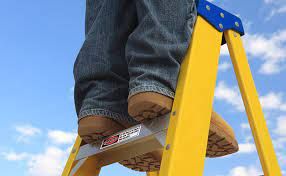Ensuring ladder safety is crucial to prevent accidents and injuries while working at heights. Whether you're painting, cleaning gutters, or performing other tasks, following proper ladder safety guidelines is essential. Here's a comprehensive guide to help you ensure ladder safety:
Choose the Right Ladder: Select the Appropriate Type: Use a ladder suitable for the specific task. Different ladders are designed for various purposes, such as step ladders, extension ladders, and platform ladders. Check Weight Capacity Ensure the ladder has an adequate weight capacity to support both you and your tools.
Inspect the Ladder: Before Each use Inspect the ladder for any damage, such as bent rungs, loose screws, or missing parts. Check for stability and ensure all locking mechanisms are functioning correctly.
Set Up on a Stable Surface: Place the ladder on a firm, level surface. Avoid soft or uneven ground. If using on an incline, use a ladder with adjustable legs or use a leveling accessory. For uneven ground, consider using leg levelers to stabilize the ladder.
Secure the Ladder: Ensure all locking mechanisms, such as spreader bars or extension locks, are engaged and secure before climbing. Tie off the top of extension ladders to a secure anchor point to prevent slipping or sliding.
Maintain Three Points of Contact: Maintain three points of contact (two hands and one foot, or two feet and one hand) while climbing and working on the ladder.
Face the Ladder: Face the ladder and keep your body centered between the side rails.
Climb Safely: Use both hands to grip the ladder rungs securely while climbing. Avoid overreaching or leaning to one side. Reposition the ladder as needed.
Stay Centered: Keep your body weight centered over the ladder and avoid leaning too far in any direction.
Use Tool Belts or Holsters: Use tool belts or holsters to carry tools, keeping your hands free for climbing and maintaining stability.
Descend Carefully: When descending, face the ladder and descend one step at a time. Continue to maintain three points of contact during descent.
Weather Considerations: Avoid using ladders in high winds or adverse weather conditions.
Train and Educate: Ensure that anyone using a ladder is trained on proper ladder safety procedures. Share ladder safety information with coworkers and team members.
Emergency Preparedness: Know the location of the nearest first aid kit and have a plan for emergencies.
In conclusion,
By following these ladder safety guidelines, you can significantly reduce the risk of accidents and injuries while working at heights. Always prioritize safety and take the time to set up and use ladders properly.

